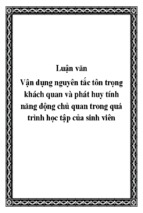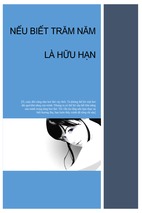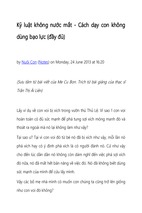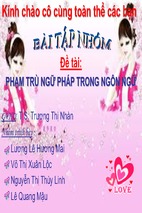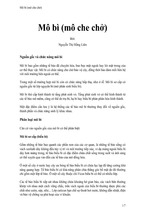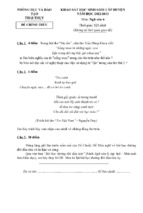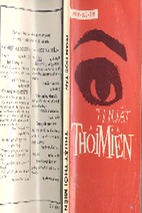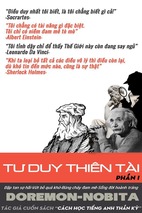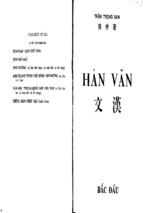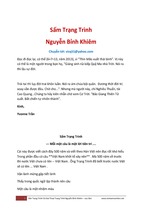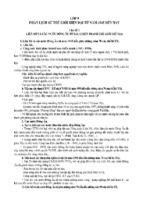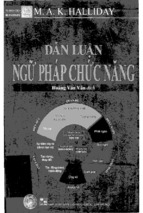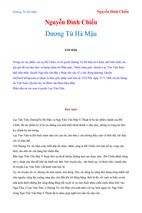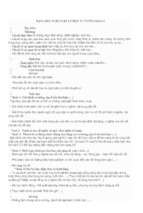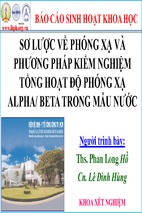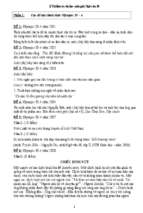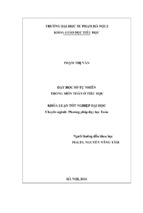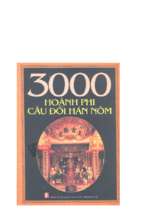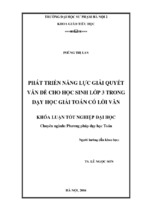SỞ GIÁO DỤC VÀ ĐÀO TẠO HÀ NỘI
TRƯỜNG THPT HOÀI ĐỨC A
*****&*****
SÁNG KIẾN KINH NGHIỆM
Tên SKKN:
AN ACTION RESEARCH ON THE EFFECTS OF PRE-WRITING ACTIVITIES ON
GRADE - 11 STUDENTS’ MOTIVATION IN WRITING
(Nghiên cứu thực nghiệm về ảnh hưởng của các hoạt động trước khi viết tới việc tăng
cường hứng thú trong kỹ năng viết cho học sinh lớp 11)
Tác giả: Phan Tiến
Lĩnh vực / Môn: tiếng Anh
Cấp học: Trung học phổ thông
Năm học: 2017 - 2018
Page 0/30
PART ONE: INTRODUCTION
I. RATIONALE
Nowadays English has become an international language because it is widely
used in many parts of the world. In the tendency of integration of the global
economy, English is one of the effective communicative tools for everybody.
The role of English is considered to be very important in the fields of
economics, politics, science, culture and education. Especially, Vietnam’s
official membership of WTO on 7th November 2006 opened a new door for
integrating into the world economy, and more and more people want to learn
English for communicating with foreign partners, tourism, and study tours, etc.
Thanks to the innovation of ways in teaching English, English lessons are
taught with four skills (listening, speaking, reading, and writing) in one unit.
Moreover, there exist three stages: pre - while - and post-teaching in one lesson.
This really helps students improve their skills beside the grammar exercises to
pass the exams.
When teaching writing skill to grade 11th students at Hoai Duc A High School
I found out that pre-writing stages are very important in teaching writing and it
also has significant effects on the students’ writing performance. If students do
not prepare well enough they can not write well, they can not even write
anything in their notebooks.
I decided to carry out the action research to find out how pre-writing stages
affect the students’ writing performance and whether the pre-lesson activities are
important to teachers of English at Hoai Duc A High School. Based on the
results of this action research, some changes and improvements could be applied
in my lessons, and some appropriate strategies needed to be designed with the
hope that students will work more effectively in a writing lesson. Hopefully that
the results of this study would be shared with any colleagues who had the same
problems or anyone who is interested in this study.
II. RESEARCH QUESTIONS
1. Do teachers highly appreciate the pre-writing activities in a writing lesson?
2. How do pre-writing activities affect the students’ writing performance?
III. METHODS OF THE STUDY
The study is basically a qualitative research, which employs the following
methods:
1. Data is collected by means of three sets of questionnaires, one on the teachers
and the others on the students in pre-improvement stage and postimprovement one. The questions are of the three kinds: close - ended
Page 1/30
questions, open - ended questions and scaling.
2. Other sources of data come from writing tasks from the textbooks. The
analysis of the data hopefully will bring about reliable findings useful for the
teaching of writing to students at my school.
1. Participants
The subjects chosen for the research include 85 grade 11th students in class
11A2, and 11A3 of Hoai Duc A High School with the survey questionnaires,
and 14 teachers who are currently teaching English. To be more specific, among
14 teachers answering the questionnaires, there were four male teachers. The
teachers’ ages range from 33 to 57. Their experience of teaching English varied
from 11 years to 32 years. The research was carried out during the first term of
the academic year 2017 - 2018 at Hoai Duc A High School.
2. Instrumentation
Instrumentation one: A set of questionnaires answered by the students in prewriting stage.
The questionnaires were designed with 5 questions to elicit from students the
information about the situation of their class in pre-writing stage, the way the
teacher carried out these activities. The questions are multiple choices.
Instrumentation two: A set of questionnaires completed by the teachers.
This set of questionnaires were designed with the aim to find out the attitude
of the teachers toward teaching pre-writing activities in a writing lesson, the
difficulties they often meet while conducting these activities and solutions to
solve the problem. In addition, their suggestions of how to make the pre-writing
activities effectively were also mentioned. To complete the questionnaires,
teachers had to tick the appropriate boxes or to give answers.
Instrumentation three: A set of questionnaires answered by the students in postwriting stage.
This was done with a view to exploring the changes that the teachers made to
change the situation, the changes from the students appreciated by them.
Instrumentation four: A collection of students’ writing papers in both preimprovement stage and post-improvement one.
IV. RESEARCH PROCEDURE
This action research consists of three main stages: Pre-Improvement stage,
Trying-out stage and Post-Improvement stage.
Stage 1: Pre-Improvement
Step 1: Identifying the problem which was wished to solve or an area which was
wished to improve by:
Page 2/30
1. Observing a lesson that illustrated the problem.
2. Conducting a survey to get information from students.
Step 2: Finding causes of the problem by:
1. Consulting with colleagues: a number of colleagues were asked to answer
three questions about the effectiveness of conducting the pre-writing
activities in writing lessons.
2. Reading professional books or journals for ideas and suggestions.
Stage 2: Trying-out
Step 3: Designing strategies for improvements (plan for action).
Step 4: Trying-out the strategies and making records of what happened in class.
Stage 3: Post-Improvement
Step 5: Evaluating the try-out by:
1. Observing a lesson that illustrated the changes that have been made.
2. Reflecting on the reasons for those changes.
3. Carrying out a survey to get information from the students.
4. Giving comments and conclusions.
V. SCOPE OF THE STUDY
This study was carried out in two English classes with 85 grade 11th students
at Hoai Duc A High School. The research focused on how pre-writing activities
affect the student’ writing performances in writing lessons.
VI. DESIGN OF THE STUDY
The research consists of three main parts: Introduction, Development and
Conclusion.
Part 1: Introduction presents the rationale, the research questions, the method of
study, the research procedure, the scope of the study, the significance of the
study and the design of the study.
Part 2: Development consists of Chapter one “Literature Review” and Chapter
two “Action Research Procedure”. In Chapter One, the theoretical background
of action research is introduced with its definition, three reasons to use it, and
ways to carry it. The concepts of writing, approaches to teaching writing and
some pre-lesson factors affecting students’ writing performance are also
presented in this chapter. What is more, the writing program for grade 11 th
students at Hoai Duc A High School is described in this chapter, too. Chapter
two namely “Action Research Procedure” describes the procedure of this action
research with the following main steps: defining the problem, observing class,
conducting a survey using questionnaires, collecting data and analyzing data,
and giving out conclusions from findings.
Page 3/30
Part 3: Conclusion is the last part which offered a summary and suggestions for
more effective writing activities and some limitations and suggestions for further
studies.
VII. SIGNIFICANCE OF THE STUDY
Writing, one of the two productive skills, has always a significant position in
language teaching. Nevertheless, how to teach and learn writing effectively
often poses great problems to both teachers and students. For the teachers of
English at high school, writing is considered a difficult skill to teach. Some of
them even ignore teaching writing skill and focus only on grammar exercises for
the exams. However, nothing is difficult if we, the teachers make decision to
make it easier. Hopefully, with a range of suggestions of how to make prewriting activities effectively in writing lessons introduced in this research, it will
be more motivating for the teachers to teach and make progress in teaching
writing. Therefore, their students will be interested in writing lessons.
PART TWO: DEVELOPMENT
CHAPTER ONE: LITERATURE REVIEW
I. ACTION RESEARCH
1. What is action research?
According to Jerry G. Grebhard (1999), the concept of action research
originated in the work of Kurt Lewin (1948, 1952). He was a social psychologist
who brought together experimental approaches to social-science research and
the idea of “social action” to address social issues. Stephen Corey (1952, 1953),
a Columbia University Professor, was among the first to use action research in
the field of education. He argued that formal research following a scientific
method had little impact on educational practice. Through action research, he
argued, changes in educational practice were possible.
In terms of what action research was, having considered what it was not
action research had been defined in many different ways. In Stephen Corey’s
definition “Action research is a way in which teachers try to study their own
problems scientifically, in an effort to evaluate, guide and correct their
procedures”. Tsui’s definition was more detailed and simpler: “Action research
is a very effective way of helping teachers to reflect on their teaching and to
come up with their own alternatives to improve their practice” (Tsui, 1993).
In another way, action research was mentioned at two levels by Grebhard and
Oprandy: “At one level, action research is about teachers identifying and posing
problems, as well as addressing issues and concerns related to the problem. It is
about working toward understanding and possibly resolving these problems by
Page 4/30
setting goals and creating and initiating a plan of action, as well as reflecting on
the degree to which the plan work. At another level, it can be about addressing
educational practices that go beyond each teacher’s classroom” (Grebhard and
Oprandy, 1999).
In brief, action research is a kind of scientific study which is often carried out
by a teacher or an educator in order to solve a practical problem in a classroom.
As it was named, it focuses mainly on the actions of both students and teachers.
So, it can solve the problems which are related to all actions and activities in a
classroom. The problems which are solved by action research are often practical
and useful for teachers.
2. Why does a teacher need action research?
Action research in schools, colleges or universities solves everyday practical
problems experienced by teachers, rather than the “theoretical problems”
defined by non-teaching researchers. It should be carried out by the teachers
themselves or by someone they commission to carry out for them.
Action research in education focuses on the three related stages of action:
1. Initiating action, such as adopting a text, choosing an alternative
assessment strategy.
2. Monitoring and adjusting, such as seeing how a pilot project is
proceeding, assessing the early progress of new programme, improving a
current practice.
3. Evaluating action, such as preparing a final report on a completed
project (Sagor, 1992).
If the teacher was trained to conduct action research, he could solve his
problems on his own or in collaboration with other teachers. Anders (1988),
Curtis (1988) and Tsui (1993) gave three reasons why a teacher needed action
research:
- to solve own problems in a scientific process and improve own practice.
- to adapt theory (findings of conventional research) to practice (own problems)
- to share the results of action research with other teachers.
Moreover, action research was also for a teacher’s professional developments.
He would become a better teacher because he knew how to find out and solve
his problems in teaching scientifically on his own. This also showed his
dynamic, activeness and imagination in his teaching job.
3. How does a teacher carry out action research in a language classroom?
Tsui (1993) suggested 5 steps in conducting action research:
Step 1: Identifying problems or an area you wish to solve or to improve by:
Page 5/30
- reviewing an audio or a video-taped lesson and the transcription of a segment
of the lesson that illustrates the problem.
- conducting a survey to hear from your students.
Step 2: Finding causes of the problem by:
- consulting with your colleagues, and trainers.
- reading professional books or journals for ideas and suggestions.
Step 3: Designing strategies for improvement (plan for action) and writing a
proposal for action research.
Step 4: Trying out the strategies (action) and keeping a diary of what happened
in the class.
Step 5: Evaluating the try-out by:
- reviewing a lesson that illustrated the changes that have been made.
- reflecting on the reasons for those changes.
- carrying out a survey to get information from students.
Other authors such as Kemmis and Mc Taggart (1998), Andy Curtis (1988)
and Nunan (1989) also recommended the similar steps in doing action research
in a classroom. Different from Tsui, in the step of “Collecting data and
identifying the problem”, Nunan (1992) suggested that teachers should observe
and make notes on what their learners and they said and did in class, and then,
based on these observations, identified positive ways to bring about this change.
In my opinion, observing the class and making notes are feasible for a teacher
to implement his/her action research where cassette recorders or camcorders are
not available.
A necessary component of action research is collaboration among different
people. They are teachers, their colleagues and students, who should be willing
to talk with each other about the problems and find out the solutions together, as
well as help each other in implementing classroom-centered action research
projects. It also needs the collaborative efforts of students who participate in the
action research project. Students’ collaboration plays an important role in the
success of the action research project.
4. Summary
Action research is a kind of scientific study carried out by a teacher which
solves the practical problems in a classroom. The teacher needs action research
to adapt theory to practice. Action research consists of three stages:
1. Pre-improvement: Firstly, the teacher identifies the problem in his teaching
job in class. He/She observes by himself/herself or asks somebody to
observe or has his/her lessons video-taped in class to get data to prove the
Page 6/30
problem. He/She also proves the problem by conducting a survey to get
information from his/her students. Secondly, the teacher tries to find out the
causes of the problem from professional books or journals, colleagues and
students.
2. Try-out: The teacher designs the strategies for improvement and tries them
out in some following lessons. Next, a lesson is observed or video-taped to
get data to illustrate the changes and improvements.
3. Post-improvement: The teacher reflects on the reasons for the changes and
improvements. To ensure the success of the applied strategies in action
research a survey is necessary to get the evaluation from students. From the
results of the action research some conclusions and comments will be made.
Action research can be carried out in collaboration with other teachers or
educators and it needs the supports from both students and education
administrators. Its results should be popularized and shared with anybody who is
interested in.
II. WRITING
1. What is writing?
In teaching a language, writing is considered one of the four language skills
(speaking, listening, reading and writing) that a learner is expected to master.
Writing is the process in which the writer expresses his thoughts or ideas in the
form of handwriting. “Writing is communicating. Good writing gets your ideas
out of your head and into the reader’s head without losing or distorting those
ideas” (Leki, 1976). To understand thoroughly the nature of writing, some more
academic definitions of writing should be studied.
According to “Oxford Advanced Learner’s Dictionary” (1989), writing is to
“make letters or other symbols on a surface, especially with a pen or pencil”.
Writing, in Davies’s point of view, involved two kinds of skills. The first ones
were low-level skills such as handwriting or typing, spelling, constructing
grammatical sentences, organizing and sequencing, structuring, drafting, and
editing.
In conclusion, Byrne’s definition can be considered one of the most complete
definitions of writing because it covers all of the features of writing given by
two above mentioned authors.
2. Why teaches writing?
When we learn a second or a foreign language, we learn to communicate with
other people: to understand them, talk to them. An integral part of participating
fully in a new culture setting is learning how to communicate when the other
Page 7/30
person is not right there in front of us, listening to our words and looking at our
gestures and facial expressions. Visitors to another country will often have to
leave a note for the mailman, fill out a customs declaration form, give written
instructions, or write a thank-you letter.
Raims (1983, page 3) thinks there is “… an additional and very important
reason: writing helps our students learn.” She shows three ways in which
students can learn through writing:
- First, writing reinforces the grammatical structures, idioms and vocabulary
that we have been teaching our students.
- Second, when our students write, they also have a chance to be adventurous
with the language, to go beyond that they have just learned to say, to take
risks.
- Thirdly, when they write, they necessarily become very involved with the
new language, the effort to express ideas and the constant use of eye, hand
and brain is a unique way to reinforce learning.
Writing is a productive skill, so it is writing that provides students with a
chance to put all those language itself and practice communicative skills at the
same time. Through the act of writing students will realize what they are already
good at and what they still need to learn to become a better and more effective
writer (also a better learner) by far, the difficult question for teachers to answer
is not “why teaches writing”, but it is how to create good reasons for writing.
3. Approaches to teaching writing
Nowadays there are many different approaches to teaching writing.
According to Ann Raims (1983, page 5-10), there were six approaches to
teaching writing namely: Controlled-to-Free Approach, Free-Writing Approach,
Paragraph-Pattern Approach, Grammar-Syntax-Organization Approach,
Communicative Approach and Process Approach.
a. Controlled-to-Free Approach
According to this approach mistakes shown up in written work was regarded
as a major problem. The teacher assumed that students made mistakes because
they wrote what they wanted freely. This approach stressed the importance of
control in teaching writing skills to students in early stages. Students were
taught how to write and combine various sentence types and manipulation
exercises were used to give students the experience of writing connected
sentences.
The amount of control would be reduced gradually and students were asked to
exercise meaningful choice. At the next stages, students might be given a good
Page 8/30
deal of guidance and content, but allowed some opportunities for selfexpression. This approach also emphasized step - by - step learning and formal
correction.
b. Free-Writing Approach
This Free-Writing encouraged students to write as much as possible and as
quickly as possible - without paying attention to mistakes. The important thing
students did was to get their ideas down on a paper. The drawbacks of this
approach were that many students wrote badly because they did not write
enough and for the same reason they felt inhibited when they picked up a pen to
write. This approach might be useful when writing a journal or a diary.
c. Paragraph-Pattern Approach
This Paragraph-Pattern Approach stressed the importance of paragraph as the
basic unit of written expression. Students were taught how to construct and
organize paragraphs. This approach helped students express themselves
effectively at a level beyond the sentence.
d. The Grammar-Syntax-Organization Approach
Writing can not be seen as composed of separate skills which are learned one
by one. So some teachers devise writing tasks that lead students to pay attention
to organization while they also work on the necessary grammar and syntax. This
approach links the purpose of a piece of writing to the forms that are needed to
convey the message.
e. Communicative Approach
This Communicative Approach emphasized the communicative role of
writing. Students should have a reason for writing and think about whom they
wrote to or for. This approach required situations which allowed them to write
purposefully. This approach motivated students to write and showed how
writing was a form of communication.
f. The Process Approach
In this approach, particular stress is paid on a cycle of writing activities which
move learners from the generation of ideas and the collection of data through to
the “publication” of a finished text:
PRE-WRITING (Specify the task/ planning and outlining/ collecting data/
making notes) → COMPOSING → REVISING (Reorganizing/ shifting
emphasis/ focusing information and style for your readership) → EDITING
(Checking grammar/ lexis/ surface features)
So in the Process Approach, students did not write on a given topic in a
restricted time and gave their writing assignments to their teachers to correct.
Page 9/30
They explored a topic through writing in an unrestricted time, showing their
teachers and each other their drafts, and using what they wrote to read over,
think about, and move them on to a new one. Teachers could give their
feedbacks on the content of what students have written in their drafts. The
writing process became a process of discovery. That was the discovery of new
ideas and new language forms to express those ideas.
To sum up, there is no one perfect way to teach writing. We, teachers have to
take into consideration the many factors of our context before deciding which
approach to apply or very likely, develop one of our own which is the
combination of some approaches and which suits our settings best.
4. What is Pre-Writing?
For most of us, getting started is often the hardest part of writing. A blank
page, begging to be filled with ink, can be intimidating, especially when our
words come slowly or when our minds go blank. Pre-writing is considered to be
very important in teaching writing. Smith (1989) stated that Pre-writing is the
complex network of initial mental sequences we undergo when we write a paper.
In addition, Richmond (1985) pointed out that Pre-writing is the first stage of the
writing process and is also called the idea - generating stage which stretches
back to include anything that you have ever done or have ever been that might
have given you ideas to write about.
III. PRE-LESSON FACTORS AFFECTING STUDENTS’
PERFORMANCE IN WRITING LESSONS
Students’ performance in writing lesson can be affected by a variety of factors
originating from students, teachers and other external factors. In the following
sections, some of the major factors will be discussed.
1. Student factors
a. Students’ learning styles
Harmer (2001) emphasizes the importance of understanding that there are
different individuals in our class if we are to plan appropriate kinds of activities
for them. Different individuals may have different learning styles, prefer
different kinds of work, and expect different degrees of care and attention from
the teacher. This can be seen clearly that there are different reactions from
students toward the pre-lesson stage. We can conclude with certainty that if
teacher realizes the differences among the individuals in the class when an
activity is in progress, the students will participate in the lesson actively.
b. Students’ motivation
Regarding the issue, there are sample definitions of motivation. Lightbown
Page 10/30
and Spada (1999) consider motivation a complex phenomenon and define it in
terms of two factors: learners’ communicative needs and their attitudes towards
the second language community while Harmer (2001) defines motivation simply
as “some kind of internal drive which pushes someone to do things in order to
achieve something”. No one can deny the importance of motivation towards the
success in learning a foreign language so we have to understand the sources of
motivation. According to Harmer, the sources of motivation are diversified.
They may derive from the society we live in, significant others like parents or
old siblings, the teacher and the method. Among these sources, the teacher and
the method may be of the most importance. For the teacher, his or her attitudes
and enthusiasm help create a positive classroom atmosphere. For the method, it
means involving both teacher and students’ confidence shown in the way of
teaching and learning. If either loses this confident motivation, the chance of
success in learning a language will be very small.
Clearly, motivation plays an important role in the success of language
learning in general but we may wonder how much or to what extent motivation
accounts for students’ participation in pre-lesson stage. We may not give the
exact answer but we can conclude with certainty that the degree of motivation is
directly proportional to the level of involvement in pre-lesson stage in common
and particularly in students’ performance in writing lesson. To be more concrete,
the more motivated students are, the more actively they will participate in the
lesson.
c. Students’ language levels
According to Harmer (2001), in a class where students’ language levels are
different, teacher may have some difficulties choosing a suitable teaching
method, language and activities used in class. Harmer claims that some
techniques and exercises are suitable for some students but less appropriate for
others. The language we use in classroom and in the materials we expose to
students must be carefully chosen concerning the complexity, length and genre.
With regard to Topic and Genre Harmer says that if students are not interested
in the topics we are asking them to talk about, they are unlikely to invest their
language production with the same amount of effort as they would if they were
excited by the subject matter. If they are unfamiliar with the type of activity we
are asking them to talk about, they may find it hard to engage themselves with
the task we have given to them. Concerning the topic and genre Harmer (2001)
suggests that teachers should take some issues into consideration such as
choosing interesting topics, creating interest in the topic, activating schemata,
Page 11/30
varying topics and genre and providing necessary information. In writing lesson,
we do not have the chance to choose the topic because of its various writing
tasks. However, teacher should choose the suitable genre or activities to
motivate students.
In brief, the limitation in the students’ language levels can directly affect their
participation however much they like the activities. We, therefore, should
choose the topics as well as the kinds of activities of their levels to encourage
their participation.
In conclusion, those are the main factors originating from students’ side that
may affect students’ participation in classroom activities. For each student, the
degrees of effect of those factors may vary and within one factor the degrees of
effect on each student are different. First, in a class may exist different learning
styles. The teacher should identify which group a student belongs to, this may
help students overcome the difficulty getting involved in the activities. Second,
students’ knowledge including both knowledge of English proficiency and
knowledge of field expertise seems directly proportional to their level of
involvement in the tasks. To be more concrete, the more knowledge students
have, the higher degree of participation is. In addition, if students are motivated,
they will engage themselves more in classroom activities.
2. Teacher factors
a. Teachers’ teaching methods
Through the history we have experienced the existence and development of
many teaching methods that can be divided into two types: teacher-centred and
learner-centred methods. In pre-lesson stage, teachers’ teaching methods are
focused on the ways teacher design appropriate activities to motivate students to
write as well as the ways that the teacher elicits pre-lesson activities. In order to
have a suitable method, the teacher should take some of the following factors
into consideration including learners, teaching purposes and other available
classroom conditions. Choosing an inappropriate or not being flexible in
applying methods to a certain class may have negative effects on students’
participation.
b. Teachers’ knowledge
In the study what makes a good teacher, Breach (2005) points out that most
students believe that the teacher is a fountain of knowledge and their main
responsibility is to pass on that knowledge to students. Breach compares the
teacher as a teapot and the students with empty cups waiting for the knowledge
from the teacher to be poured down in. In the pre-lesson stage of writing lesson,
Page 12/30
we are going to focus on language ability and general knowledge.
Language: According to Underwood (1987), being a fluent, accurate English
speaker is a great help, but this alone does not make us a successful teacher.
Indeed, many teachers whose command of English is limited still are good
teachers as they understand the difficulties their students often face. According
to Underwood the secrete lies in being confident about the language we use and
we should not feel embarrassed due to the lack of greater knowledge.
General knowledge: In order to conduct a useful pre-lesson activity, a teacher
needs not only knowledge of the language but also knowledge of content which
means the knowledge of the topic they are going to conduct. According to
Underwood, the more knowledge of the lesson a teacher can apply to his lesson,
the more interested his students will feel in because the students can experience
language being used.
c. Teachers’ instructions
Complicated instructions are another major problem that often makes giving
instructions very time-consuming. In the class, if the students do not understand
the teachers’ instructions, they do not react anything. Therefore, the teacher has
to try at least twice to explain to them before resorting to Vietnamese. Much has
been written on how to give effective instructions. Ur (1996) provides several
very useful recommendations: The first step is to prepare what you are going to
say, and if possible, even to write it down. Then the teacher needs to ensure the
class’s attention. Next, he should give the information more than once. Make
sure that the language is brief and clear, and then follow it up with
demonstrations. Giving effective instructions is not as easy as some teachers
may think. It is a skill that we can gain only with proper learning and frequent
practice.
In conclusion, students’ writing performance can be affected by teachers’
factors including teaching methods, teachers’ knowledge and teachers’
instructions in pre-lesson stage. Teaching methods may play a decisive part in
obtaining teaching goals in pre-lesson stage. Beside teaching methods, teachers’
knowledge also plays an important part as the former makes the activities
interesting in term of the content. Additionally, the fact those teachers’
instructions properly may help students be sure that they can understand what
they need to do in the lesson. Thus, with a view to improve the pre-lesson stage
in writing lesson, teachers should renovate their teaching methods, in this case
that is the way teachers elicit the pre-lesson activities. At the same time, teachers
should improve their knowledge including both knowledge of language and
Page 13/30
knowledge of the field expertise. Finally, teachers should give clear and brief
instructions in this stage so that students can produce good writing pieces.
3. External factors.
a. Time limitations
Normally, in pre-lesson stage, only 5 to 10 minutes are used to conduct the
activities. However, if teachers, for some reasons, do not prepare the materials
well enough, they will realize the failure of having pre-lesson activities
immediately. Moreover, in some large classes with a number of students whose
English knowledge are limited, it often takes time to conduct these activities.
This leads to the confirmation of the teachers’ role in designing appropriate
materials in pre-lesson activities.
b. Classroom and materials restraints
According to Williams and Burden (1997), we can not underestimate the
importance of appropriate environmental conditions for learning to take place as
an understanding of the ways in which aspects of the environment affect
learning is vitally important for language teachers and learners.
Underwood (1987) points out some factors related to the classroom physical
conditions that can affect the learning process:
The lightness
The temperature and fresh air
The acoustics
The lines of vision
The layout of the desks/ tables
The possibility of moving desks/ tables
The other furniture
The facilities for displaying pictures, charts, etc
It is common that in Vietnamese high school, visual aids are not available so
that teachers have to prepare the materials by themselves and this leads to the
fact that Vietnamese English teachers do not use the materials regularly and
effectively. In some cases, teachers do not use the visual aids effectively such as
they use the pictures in small sizes so that students can not see what exactly are
shown on the board or they use the visual aids which do not match with the
topics of the lessons.
No one can deny the role of classroom atmosphere in the success of language
learning. According to Underwood (1987), both the teacher and students are
responsible for creating a good atmosphere and a good learning atmosphere
consists of some characteristics such as giving a sense of purpose or the teachers
Page 14/30
should ensure that English is spoken. Balancing fluency and accuracy or using
appropriate language are the two necessary elements in creating a good
classroom atmosphere. Underwood also mentioned the effects of encouragement
as well as students’ involvement on the improvement of students’ English
learning. Last but not least, tests and extracurricular activities are also
considered as important parts of increasing learning atmosphere in the
classroom.
IV. THE WRITING PROGRAM FOR GRADE 11TH STUDENTS
1. The objectives of the program
Basing on the new textbooks designed by the Ministry of Education and
Training, English is taught with four skills and Language Focus which focuses
on grammar and pronunciation. The writing program at Hoai Duc A High
School follows the syllabus of the MOET (Ministry of Education and Training)
with the aim of improving students’ abilities in writing. On English 11 textbook,
there are a range of types to practice writing with narrative, writing letters,
describing statistics from a chart or a table or writing a report or a biography.
As regards the language, students sometimes have to depend on the provided
structures and phrases or vocabularies. However, some of them start to be aware
of and perform different styles as well as various levels of formality to match the
writing situation. But most of their works still need to be examined for
vocabulary and style accuracy.
In terms of methodology, students are expected to master the general study
skills. Students should be active in self-studying, peer and group cooperation.
They understand the process in teaching and learning writing and know how to
write.
2. The teaching materials
The course books used to teach writing skills to grade 11th students of Hoai
Duc A High School is English 11 by MOET.
3. The schedule of the course
There are 3 periods of English in a week. In Hoai Duc A High School, we
spend two weeks for one unit because each unit is taught from five to six
periods.
The teaching and learning tasks for the academic year will be scheduled as
follows:
Unit 1: Friendship - Writing a narrative: Writing about your friend
Unit 2: Writing a personal letter to describe a past experience
Unit 3: A Party - Writing an informal letter of invitation
Page 15/30
Unit 4: Volunteer work - Writing a formal letter expressing gratitude
Unit 6: Competitions - Writing a letter of reply
Unit 7: World population - Interpreting statistics on population from a chart
Unit 8: Celebrations - Describing a celebration’s activities
Unit 9: Writing a formal letter to express satisfaction or dissatisfaction
Unit 10: Nature in danger - Describing a location
Unit 11: Sources of energy - Describing information from a chart
Unit 12: Describing the preparations for the coming Asian Games
Unit 13: Hobbies - Writing about a collection
Unit 15: Space Conquest - Writing a biography
Unit 16: The Wonders of the world - Writing a report on a man-made place
CHAPTER TWO: ACTION RESEARCH PROCEDURE
I. PRE-IMPROVEMENT STAGE
STEP 1: IDENTIFYING THE PROBLEM
1. Identifying the problem
The action research was carried out with the aim of finding “The effects of
pre-writing activities on grade 11th students’ writing performance at my school”
While teaching writing here, I realize that some English teachers, for some
reasons, do not usually conduct the pre-writing activities effectively at writing
lessons. To make it clearly how pre-writing activities affect to the students’
writing performance, some factors related to students’ participation in prewriting stage will be discussed in this part.
2. Observing a lesson that illustrated the problem
Three volunteer teachers from other classes were asked to come to classes
11A2, and 11A3 in two different periods to observe the writing lesson without
notifying to the teacher and all the students in that class. The observers just
focused on what the teacher did in pre-writing stage and the reaction of students
in the class at this stage. What is more, the teachers collected some of students’
writing papers in order to compare the differences in students’ writing
performance between the pre and post improvement stage of this research.
A. BRIEF DESCRIPTION OF THE LESSON
1. Topic for the writing task. “Writing a formal letter expressing gratitude”
2. Time allowance: 10 minutes (3 minutes for warm up and 7 minutes for prewriting activities)
B. THE RESULTS OF PRE-IMPROVEMENT CLASS OBSERVATION
Class
T’s activities
Ss’ activities
Comments
This is a typical
11A2 For warm up:
Page 16/30
- T pointed at the textbook Some of them said lesson
of
a
and asked Ss “What is this?” “It is a letter”. Some careless teacher.
- OK. Today we are going said nothing, some She
did
not
to learn how to write a kept on personal prepare anything
formal letter of expressing talks.
for the lesson so
gratitude.
The class was noisy students felt bored
because of the hot with her lesson so
For pre-writing stage:
T asked her Ss to do Task 1, weather. Most of that their writing
and she explained some new the students did performance
words such as donated, nothing and only would be affected.
gratitude, …
some
of
them
T asked Ss to do Task 2 for listened to what the
the while writing stage.
teacher said.
This is a teacher11A3 For warm up:
T showed a letter copied in “Yes”
centered teaching
A4 paper and asked Ss “Can
approach. T didn’t
you see what do you call
notice the feelings
this? Is this a letter?”
of the students. T
Students
seemed even gave a wrong
For pre-writing stage:
T also asked Ss to do task 1 tired and nervous sentence “Can you
in the textbook and then she and tried to finish see what do you
answered all the questions their task.
call this?” at
by herself if there was no
warm up stage.
reply from the students.
This shows that T
T also asked Ss to do task 2
didn’t prepare the
with no emphasis on what
lesson plan before
they had to do to write a
teaching
that
letter of expressing gratitude
writing lesson.
The above results show that the problem of ineffective pre-writing activities
was true in writing lessons. The next step is to conduct a survey to find out the
causes of the problem from students.
3. Conducting a survey to get information from students
85 students were asked to give their answers to the 5 questions and then
handed in their papers to the teacher. These were the results of the survey:
Question 1: What is your self-assessment on your writing performance today?
Very bad
Bad
Fair
Good
Very Good
No
%
No
%
No
%
No
%
No
%
Page 17/30
37
43.5
24
28.2
8
9.4
10
11.8
6
7.1
The data in Table 1 shows that the writing performance of the grade 11 th
students at my school was not good. The percentage of the students who thought
their writing performance on that day was very bad (43.5%) and bad (28.2%).
What is more, 9.4% of the asked students assessed that they had no idea of their
writing performance. Meanwhile, the percentage of the students thinking their
writing performance was good and very good was 11.8% and 7.1% respectively.
Clearly, the findings show us that most of the students feel their writing
performance will be monotonous if there is nothing improved.
Question 2: Does your teacher ask you to join in the pre-writing activities
today?
All the students (100%) are asked to join in the pre-writing activities on that
period. This shows that the trend of having pre-writing activities in the writing
lesson is very popular in my school.
Question
Yes No
Does your teacher ask you to join in the pre-writing activities 100% 0%
today?
Question 3: Do you like those pre-writing activities? If No, please answer the
next question.
No
Yes
As can be seen from the chart, almost all the students (79.8%) who were
asked did not like the activities of the teachers whereas 20.2% of them stated
that they liked the pre-activities that the teacher conducted on that day.
Question 4: Why aren’t you interested in taking part in the pre-writing activities
today?
Reasons
No
%
My vocabulary and grammar structures are so poor
35
41.2%
I don’t know much about the writing topic
22
25.9%
The topic is not a “hot” one
11
12.9%
I don’t feel being motivated enough
9
10.6%
Others (the classroom is not comfortable enough with
8
9.4%
the dim lights, the picture is so small to see, the fans
Page 18/30
spin slowly)
As can be seen from the table, a large majority of the students (41.2%) stated
that their vocabulary and grammar structures were not enough to take part in the
pre-writing activities on that day. 25.9% of them said that they did not know
much about the topic. One more reason for the inactiveness of students in that
pre-writing activity is that students thought that the topic was not “hot” enough.
This accounted for 12.9% of the students. Motivation and other classroom
effects added 10.6% and 9.4% respectively to the list. From the information
collected, teachers at my school should be aware of some factors affecting to the
students’ participation in pre-writing stage so that they can conduct more
effective activities that help students write better.
STEP 2: FINDING CAUSES OF THE PROBLEM
1. Consulting with colleagues
In order to get more professional advice, suggestions and ideas about the
problem of finding out “the effects of pre-writing activities to students’ writing
performance” and with the aims of making teachers at my school realized the
importance of pre-writing activities in teaching writing I consulted with 14
English teachers who are teaching in the English Division at my school.
The following questions were chosen for teachers of English in the English
Division at my school to answer on piece of paper:
Question 1. According to you, how important these activities affect to students’
writing performance?
Item No
(1) Least important → Most important (5)
1 (%)
2 (%)
3 (%)
4 (%)
5 (%)
a
0
6.7
26.6
33.4
33.3
b
6.7
13.6
6.9
53.5
19.3
c
0
42.3
20.4
26.2
11.1
d
17.1
32.5
42.7
2.4
5.3
a. Warm - up activities.
b. Pre - writing activities
c. While - writing activities.
d. After - writing activities.
Table 6 summarizes the teachers’ ideas about the importance of pre-writing
activities on students’ writing performance. In general, they thought that prewriting activities affect most students’ writing performance. Coming back to the
above analysis, we also can see that warm-up activities ranked the second after
pre-writing activities in the teachers’ view toward its relationship with students’
writing performance meanwhile while and after-writing stage were appreciated
less important than the above activities.
Page 19/30
- Xem thêm -


